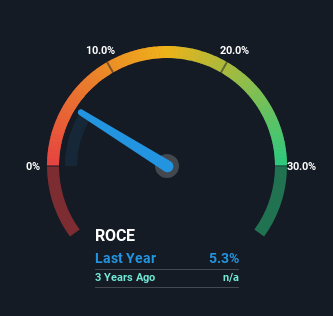Be Wary Of Sejal Glass (NSE:SEJALLTD) And Its Returns On Capital

Did you know there are some financial metrics that can provide clues of a potential multi-bagger? Ideally, a business will show two trends; firstly a growing return on capital employed (ROCE) and secondly, an increasing amount of capital employed. This shows us that it's a compounding machine, able to continually reinvest its earnings back into the business and generate higher returns. However, after investigating Sejal Glass (NSE:SEJALLTD), we don't think it's current trends fit the mold of a multi-bagger.
What Is Return On Capital Employed (ROCE)?
For those who don't know, ROCE is a measure of a company's yearly pre-tax profit (its return), relative to the capital employed in the business. The formula for this calculation on Sejal Glass is:
Return on Capital Employed = Earnings Before Interest and Tax (EBIT) ÷ (Total Assets - Current Liabilities)
0.053 = ₹82m ÷ (₹2.1b - ₹522m) (Based on the trailing twelve months to September 2023).
Thus, Sejal Glass has an ROCE of 5.3%. In absolute terms, that's a low return and it also under-performs the Building industry average of 17%.
See our latest analysis for Sejal Glass

While the past is not representative of the future, it can be helpful to know how a company has performed historically, which is why we have this chart above. If you want to delve into the historical earnings, revenue and cash flow of Sejal Glass, check out these free graphs here.
How Are Returns Trending?
We weren't thrilled with the trend because Sejal Glass' ROCE has reduced by 84% over the last two years, while the business employed 1,778% more capital. That being said, Sejal Glass raised some capital prior to their latest results being released, so that could partly explain the increase in capital employed. The funds raised likely haven't been put to work yet so it's worth watching what happens in the future with Sejal Glass' earnings and if they change as a result from the capital raise.
On a related note, Sejal Glass has decreased its current liabilities to 25% of total assets. Since the ratio used to be 80%, that's a significant reduction and it no doubt explains the drop in ROCE. What's more, this can reduce some aspects of risk to the business because now the company's suppliers or short-term creditors are funding less of its operations. Since the business is basically funding more of its operations with it's own money, you could argue this has made the business less efficient at generating ROCE.
The Bottom Line
In summary, despite lower returns in the short term, we're encouraged to see that Sejal Glass is reinvesting for growth and has higher sales as a result. In light of this, the stock has only gained 5.9% over the last year. Therefore we'd recommend looking further into this stock to confirm if it has the makings of a good investment.
If you'd like to know more about Sejal Glass, we've spotted 4 warning signs, and 2 of them can't be ignored.
While Sejal Glass isn't earning the highest return, check out this free list of companies that are earning high returns on equity with solid balance sheets.
New: Manage All Your Stock Portfolios in One Place
We've created the ultimate portfolio companion for stock investors, and it's free.
• Connect an unlimited number of Portfolios and see your total in one currency
• Be alerted to new Warning Signs or Risks via email or mobile
• Track the Fair Value of your stocks
Have feedback on this article? Concerned about the content? Get in touch with us directly. Alternatively, email editorial-team (at) simplywallst.com.
This article by Simply Wall St is general in nature. We provide commentary based on historical data and analyst forecasts only using an unbiased methodology and our articles are not intended to be financial advice. It does not constitute a recommendation to buy or sell any stock, and does not take account of your objectives, or your financial situation. We aim to bring you long-term focused analysis driven by fundamental data. Note that our analysis may not factor in the latest price-sensitive company announcements or qualitative material. Simply Wall St has no position in any stocks mentioned.
About NSEI:SEJALLTD
Sejal Glass
Manufactures and sells value added glass in India and internationally.
Solid track record with mediocre balance sheet.
Market Insights
Community Narratives




